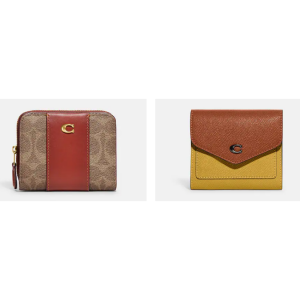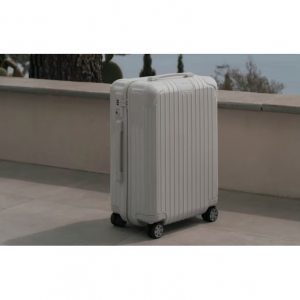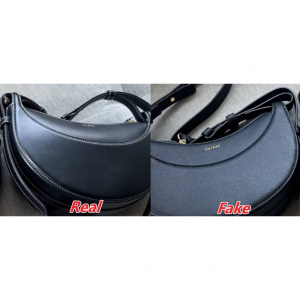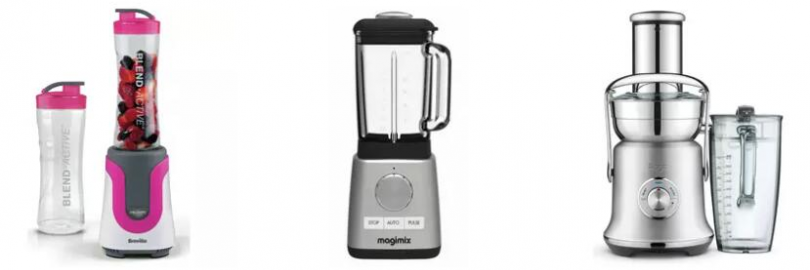
Blender vs. Juicer vs. Food Processor vs. Mixer: Which Should I Choose?
If you're tired of doing everything by hand in the kitchen, there are plenty of handy gadgets that can take you out of your cooking and baking chores. You can spend anywhere from $10 to over $600, and you'll find some products are all-rounders, while others are good at specific tasks.
Different types of kitchen appliances have been introduced into the market. Want to make a delicious drink at home but can't decide if you need a blender, juicer or smoothie maker?
We describe their use in detail below. These machines play an important role in making the cooking process easy and comfortable. Some of the appliances that we typically need in our kitchens these days are juicers, blenders, grinders, stand mixers, and food processors. Many brands are making these machines, offering them in a variety of qualities and at different prices. These terms are sometimes used interchangeably, but we describe the basic differences between them below.
Should you buy a food processor, stand mixer or something else? Use our guide to find the best kitchen gadgets for you!
Find out the pros and cons of each and learn the difference between kitchen appliances: juicers, mixers, grinders, blenders, food processors.
Buy the world's best collection of small kitchen appliances from the official online stores or from online retailers. You’ll get a good deal on a wide variety of small appliances suited towards all sorts of cooking and preparation needs.
Main types of food preparation kitchen appliances and what they're for?
Baking (Food mixers)
Chopping, slicing, mincing (Food processors/choppers & grinders)
Soups and liquids (Blenders and soupmakers)
Drinks (Juicers and smoothie makers)
What kind of food you're going to prepare may dictate what kind of kitchen tools you should use. Next we will detail what are they? What is the use? Is it worth buying? What are the brand choices? Which is the best model? What is the best deal?
In fact, here's a great money-saving tip:
In fact, you can save up to 100% on online shopping at home and abroad!
Such a high amount of cash back comes from Extrabux (What is Extrabux?), it also offers coupon codes and recent promotions, and brings together 10,000+ sites (US, China, UK, Japan, Australia , Germany, France, Italy, etc.).
Just sign up for an Extrabux account and earn exciting cash back every time you place an order via the relevant link. Sign-Up Bonus: Join for FREE & Earn $20 Welcome Bonus today! Then earn $5 Friend Referral Bonus!
Whether you are buying cheap domestic products, international luxury goods, or buying mobile phones, computers, refrigerators, washing machines, clothes, shoes, bags, mother and baby products, snacks, drinks, or booking air tickets, hotels, car rentals, or registering services and memberships , you can save money on all related purchases - save $1,000 a year!
Best for chopping, slicing & mincing
Food processor
Chopper
Grinder
Food processor

Food Processor is a multifunctional appliance that’s ideal for large families and entertaining.
What does a food processor do? A food processor can take care of tedious tasks for you, such as kneading dough, whisking egg whites, finely and evenly slicing fruit and vegetables, grating cheese, to even blending soups and smoothies!
Just about every action that creates masterpieces in your kitchen can be done with a food processor.
Features of Food Processors
Here are a few of the most common features on a food processor:
Chopping
Slicing
Mixing
Whisking
Pureeing
Blending
Whipping
Kneading dough
Grating
Shredding
While some food processors will include all of the above features, some food processors will have only a select few – so ask yourself which features or functions you’ll primarily be using on the food processor.
Why you need one
Makes labor-intensive and tedious preparations quick and easy.
Can handle a range of cooking and baking preparation tasks
Replace mandolines, grinders, blenders, mixers, mortars and pestles, and box graters.
Perfect for making pastries and doughs, grating, chopping and slicing fruits and vegetables, and grating hard cheeses. Make dips, curries, batters, and mayonnaise, and chop up bread crumbs.
Anyone looking to save time in the kitchen but like to make everything from scratch.
People who prepare lots of fruits and vegetables - i.e. vegetarians and vegans.
Why you don't need one
It's not suitable for mixing soups, cocktails, and smoothies unless it comes with a whisk attachment.
They can be bulky and take up valuable bench and cabinet space
Setup and cleaning can be tedious and time-consuming
Settings of Food Processor
Most food processors will have three settings: on, off and ‘pulse’. The ‘on’ function makes the processor run continuously, while the pulse setting causes it to blend in short bursts for additional control. More advanced blenders may have different speed settings within the pulse feature (high or low), but a single pulse features is usually adequate for most households.
What brands and discounts are there for food processors?
Buy from the best range of food processors in online or in store at home and abroad.
You'll get great deals on leading food processors brands including the most popular KitchenAid, Kenwood, Breville, Sunbeam, Cuisinart, Kambrook, Magimix, and more.
A food processor is the ultimate kitchen accessory for quickly and easily chopping, slicing, shredding, shredding, grating, shredding and pureeing a variety of vegetables and fruits. Mix, mix, knead dough, and process foods—you can whip up all your favorite soups, cake batters, sauces, and more at the touch of a button.
No matter what brand, style or price range you prefer, you can find the food processor that's right for you with Extrabux and save some money.
Best food processors for chopping, slicing and shredding 2025
Most compact: KitchenAid KFP0718CU Food Processor, 7 Cup
($79.99 FROM KitchenAid - Save 20% & Get Up To 5% Cash Back)

Brand with proven long-lasting performance
Easy to store, with a compact design, in-bowl accessory storage and convenient cord wrap.
Innovative reversible stacking discs
Cost-effective
Easy-to-clean, airtight, leak-proof work bowl; dishwasher safe bowl, lid and accessories.
Easy to clean, sealed, leak-resistant work bowl; dishwasher-safe bowl, lid & accessories.
3 speed options (High, Low and Pulse) and easy to press paddles with illuminated LED controls
Chop, Puree, Shred and Slice everything from cucumbers to tomatoes, cheeses and more with the reversible medium slicing/shredding disc and multi-purpose blade.
Process a variety of shapes and sizes in the 2-in-1 feed tube
The machine diced, chopped and shredded with the same consistency as the Cuisinart, though was just shy of the Breville on the fine mince.
Chopper

Electric chopper is vegetable choppers which are packaged compact machine which comprises of a large bowl, stainless steel blades and a powerful motor with one-touch power control.
It can be used to do various tasks such as chopping, mincing, slicing, grinding, and cubing of ingredients like vegetables, fruits, nuts, meat, and cheese.
Smaller than a standard food processor, these are better for working with reduced quantities and spaces with little storage.
You can use it to chop onions, tomatoes, carrots, cucumbers, peppers, celery—really anything you'd like chopped up.
Why you need one
Compact and affordable
Tend to be simple to use and clean
Great for quick, small jobs
Why you don't need one
Usually limited to chopping and puréeing
Small capacity
What brands and discounts are there for Choppers?
Choppers are mini food processors designed for processing small amounts of food, such as a handful of nuts or onions.
The most popular chopper brands are Kuhn Rikon, Cuisinart, KitchenAid, OXO, MOSAIC. Shop chopper online at a great discount with Extrabux.
Best Vegetable Choppers for Faster Food Prep
Best Overall: KitchenAid 3.5-Cup Food Chopper
($54.99 FROM KitchenAid - Save 8% & Get Up To 5% Cash Back)

Like many KitchenAid appliances, this unit comes in a variety of colors to match the kitchen or add a pop of color.
Easy cleanup
Compact design
Comes with whipper attachment
3.5 cup work bowl features a locking blade, handle and pour spout for easy serving.
Master tasty dressings and sauces with the drizzle basin.
2 speeds and pulse operation give you precise control to produce coarse or fine results.
Easy to clean, dishwasher-safe work bowl, lid and blade.
Grinder
If you want to join the homemade burger revolution or love to make your own salsas, or even baby food, then a grinder is perfect. They’re ideal for meats, fish and veg. You could even whip up your own spice mixes.
Best for baking
Stand mixer
Hand mixer
Stand mixer

If you're a big fan of home baking, then you should definitely make sure you have a food mixer in your kitchen. Look out for ‘stand mixers’ too, they do the same thing, but just have a different name.
Stand mixers take all the arm ache out of manual mixing, whipping, and kneading, and make getting that perfect consistency as easy as the flick of a switch.
Best for making cakes, breads and pizza doughs, stand mixers can handle heavy batters and bigger batches.
A range of settings means you can mix with precision, and different accessories make it easy to get professional results every time.
Why you need one
Knead the dough, mix the batter, whisk the cream and egg whites.
Some stand mixers can accommodate other attachments as optional accessories, such as meat grinders, pasta makers, blenders, citrus juicers, sausage makers, food processors, and fruit presses.
Usually has a larger capacity than a food processor.
For those who just like to bake cakes, breads, cookies, meringues, marshmallows, puff pastries. Great for baking.
Why you don't need one
Functionality is limited if they cannot accommodate the optional extras mentioned above.
Can be expensive.
It cannot be blended, chopped or pureed.
May not hold small amounts, such as whisking two egg whites.
Bulky and takes up space.
What brands and discounts are there for stand mixers?
Popular brands of kitchen stand mixers include Breville, Kenwood, KitchenAid, Smeg and Sunbeam.
Stand mixers (also known as food mixers) are designed for baking tasks. They tend to have a large mixing bowl so you can bake larger batches too.
Kneading, mixing and whisking are their key strengths, but some come with extra attachments for blending, grating, slicing and mincing food. Brands such as KitchenAid and Kenwood sell a wide range of accessories you can use with them, from ice-cream makers to spiralizers, although these can be expensive.
Stand mixers tend to be larger and more expensive than other food preparation gadgets. Prices range from $100 to $800, but usually cost around $300.
They can be a worthwhile investment for regular bakers, as they tend to do a better job of key baking tasks. You'll go shopping through Extrabux and find the blender that's right for you, then you can save some money.
These small kitchen appliances are also available in a variety of colors to match your kitchen.
The best stand mixers in 2025
Best Overall: KitchenAid Artisan Tilt-Head Stand Mixer
($399.99 FROM KitchenAid - Save 11% & Get Up To 5% Cash Back)

Tried and loved by us, the KitchenAid Artisan Series 5-Qt. Tested on four KitchenAid models (Classic, Artisan, Mini and Pro Line), Artisan is the perfect choice for the everyday baker.
10-speed slide control ranges from a very fast whip to a very slow stir
Includes Flat Beater, Dough Hook and Wire Whip
Power Hub for Additional Attachments,Volts- 120
Unique Mixing Action. Hub cover - non-hinged
Assembled with Pride in Greenville, Ohio
Choose from all the color options to find the one that best matches your style and personality.
The power hub turns your stand mixer into a culinary center with more than 15 optional attachments available.
5-Qt. stainless steel bowl with comfortable handle offers enough capacity to mix dough for 9 dozen cookies or 4 loaves of bread in a single batch.
59-Point Planetary Mixing Action means 59 touchpoints per rotation around the bowl for thorough ingredient incorporation.
The tilt-head design allows clear access to the bowl and attached beater or accessory so you can easily add ingredients for a recipe.
Powerful enough for nearly any task or recipe, whether you’re stirring wet and dry ingredients together, kneading bread dough or whipping cream.
Includes coated flat beater, coated dough hook, 6-wire whip and 1-piece pouring shield. The flat beater and dough hook are dishwasher-safe.
Hand mixer

A smaller version of the stand mixer, perfect for those smaller baking jobs like beating eggs, mixing frosting, or forming batters. And because these don't have a bowl, you can use them with any mixing bowl you have -- big or small.
Why you need one
Helps reduce the burden of mixing and stirring
Beat egg whites, whip cream, mix cake batter, mix frosting to make smooth and creamy mashed potatoes.
Great for small batches.
Small in size and easy to store.
Prices as low as $15
Some include mini attachments, such as mini processors and stir sticks.
Why you don't need one
You don't like baking.
May be tired
May be difficult to handle heavier or larger loads
They cannot knead dough or heavy cookie dough and batter very efficiently due to having to hold a mixer.
What brands and discounts are there for mixers?
Best for lighter jobs or occasional bakers. Handheld mixers usually have attachments for mixing, whisking and kneading and get the job done faster than you would by hand. They are a cheap and space-saving alternative to a stand mixer that you can use with any mixing bowl you have to hand. Popular brands of hand mixers include Kenwood, Breville, KitchenAid, Bodum, Sunbeam.
Best Hand Mixers of 2025
Best Overall: Breville Handy Mix Scraper Hand Mixer
Buy it: $140; Amazon

Breville's hand mixer won our Kitchen Appliances Lab's test, earning top scores in egg white whipping, cake batter beating, oatmeal cooking mixing, bread dough kneading and more.
BEATER IQ TECHNOLOGY: Whether you’re whisking cream or kneading dough, the Handy Mix Scraper detects which attachment you’re using and automatically recalibrates to the perfect speed.
QUIET SCRAPER BEATERS: No clinging or clanging in your kitchen. The rubber Scraper Beater maximizes contact with the bowl while minimizing sound, to ensure you incorporate all ingredients for more thorough mixing.
9 SPEED SETTINGS: 9 speeds plus boost to ensure precise speed for your mixing load.
COMFORTABLE DESIGN: An ergonomic handle creates a natural hand position so mixing never feels like a chore.
COMPACT STORAGE: A detachable storage compartment houses all the attachments and swivel cord so you’ll love this mixer even when it’s turned off.
What To Consider When Buying A Mixer
A basic kitchen mixer will get those common, everyday mixing jobs done. However, to ensure you’re getting a mixer that will do what you need it to do, or to get more consistent results, there are a few things to consider.
Size And Weight
If you’ll only be using your mixer for the occasional homemade cake or trying out a simple new recipe, a smaller stand mixer or hand mixer should do the job.
Look for a larger stand mixer with a bigger bowl if you like cooking in batches, run the cake stall at the school fete, or have your own cupcake side hustle. Smaller bowls hold about 3.8 litres while extra large bowls hold about 6.7 litres. Also remember that the heavier the unit, the less likely it is to move or shuffle around on your benchtop while mixing.
This is all about getting the balance between a mixer that’s heavy enough to stand up on its end without falling over, and one that’s light enough to fluff frosting for 5 minutes without your arm feeling like it’s going to fall off. Anything 700-900g should be good.
Power And Wattage
Look for a hand mixer with at least 200 to 250 watts of power for better performance and longevity. Stand mixers should have a minimum 250 watts of power to handle thicker batters, but they go all the way up to 1000 watts. Just remember the higher the wattage, the more powerful your mixer will be.
Speed Settings
The more speed settings your mixer has, the more you can control the end result. You might not end up using all of them, but a mixer with 10 speed settings will give you more options and smoother transitions than one with three settings.
Pulse
Some mixers come with a pulse function that uses a small burst of power whenever you need it, so you’ll never over-egg the pudding! Perfectionists should look out for this little added extra.
Bowl Material
Most kitchen mixer bowls are made from lightweight and durable stainless steel. Glass and ceramic options are also available, but require more care as they can chip or crack.
Style
How it looks in your kitchen is a big deal. You could add a pop of colour with a classic red or go for a cool grey – the choice is yours. You can even choose your preferred metal finish, whether that’s brushed or polished.
Attachments
Most stand mixers will come with a beater for mixing, a dough hook for kneading, and a whisk for… well, whisking. Look out for added extras you might want, like a splashguard. This will cover the mixing bowl when it’s in use and stop ingredients from flying out over the sides.
Best for soups & liquids
Blender
Soup maker
Blender
Blenders are a small kitchen appliance best used for preparing drinks like smoothies and milkshakes, crushing ice and frozen ingredients, or foods that you would normally pour or drizzle. Some blenders are designed for both hot or cold, like some of the Ninja blenders or Vitamix blenders that can handle blending hot soups. All blenders will crush ice. Some manufacturers will say to add liquid so make sure you consult the user manual.
There are 3 main types of blenders.
Full-Size Blenders:
Designed to be placed on the countertop, also known as a high-performance blenders. Equipped with powerful motors and fast-spinning blades, they can make frozen drinks, hot soups, sauces or churn-free ice cream.They're getting more advanced, and some blenders have the speed and features needed to make homemade butters and spreads, whip natural jellies or jams, and even aerate wine.
Personal Blenders:
Personal and single-serve blenders are great for making power shakes and yogurt smoothies, but not for hard-core blends.
While these smaller units typically only hold 1 or 2 servings at a time and lack the shredding and dicing capabilities of full-size models, they are a very popular option. Perfect for making personal-sized smoothies, shakes, and afternoon cocktails, they feature a travel lid and handle so you can take your drink with you on the go.
Immersion/Stick Blenders:
Intended to be more of a complement to full-size and personal blenders than a replacement, immersion or stick blender, is a versatile device designed to be immersed in a pot or bowl. They're not designed for chopping or slicing, but are great for making smooth liquids. In addition to its usual use in mixed soups, other unique uses include making whipped cream, balsamic vinegar, pesto or pancake batter.
Standard blenders
Popular brands include Breville, KitchenAid, Electrolux, Sunbeam, Kenwood and Cuisinart.
Why you need one
Traditional blenders can emulsify mayonnaise, puree soups, make smoothies, and blend frozen drinks and cocktails.
Relatively cheap.
More capacity for blending smoothies and soups.
Why you don't need one
They don't knead dough, mash potatoes, grind nuts, make nut butter, chop vegetables, or chop breadcrumbs.
May not give you a silky smooth smoothie or blend well with fibrous leafy vegetables.
Can be noisy.
High-performance blenders
Popular brands of these 'super blenders' include Vitamix, Breville, Optimum, Oster, Blendtec, KitchenAid and BioChef.
Why you need one
High-performance blender for emulsifying dressings and mayonnaise, making soup purees, making silky smoothies and blending cocktails, sorbets, grinding nut butters and crushed ice. Some spin so quickly that they even heat raw vegetables and liquids to a mild temperature, making for a quick and healthy soup.
If you are committed to healthy eating and want velvety smoothies, purees and soups.
Construction-wise, they are stronger than cheaper blenders.
Why you don't need one
Expensive
Do not knead dough or mashed potatoes.
It may be necessary to purchase an expensive dry jug for grinding.
Can be bulky and take up valuable bench and cabinet space.
Can be very noisy.
Single-serve blenders
Also known as personal blenders, popular models include the Nutribullet, Nutri Ninja and MagicBullet.
Why you need one
Blend fruits and vegetables into a liquid that you can drink from the same bottle on the go. Usually some water is added to help with blending.
It will help you incorporate whole foods into your diet in drinkable form.
RDIs that can increase your fruit and vegetable intake.
A great way for kids to get fruits and vegetables into their diet.
Perfect for busy office workers and school-going kids who can make a healthy blend of fruit and vegetables every day without much supervision.
Why you don't need one
They are not as powerful as high performance blenders.
Usually operates on an impulse function.
You will usually only be able to process it for up to a minute before you need to add liquid to the fruit and vegetables to blend.
The juice will warm up slightly after processing, so you may need to add a small amount of ice cubes or frozen fruit while stirring to avoid heating the smoothie.
You don't like juicy, frothy drinks.
They can be noisy.
What brands and discounts are there for blenders?
Best for whipping smoothies and soups.
The best blenders quickly blend smoothies and soups to smooth consistency. Usually no option to chop, slice, whisk or knead.
Most can also crush ice cubes and dips, and some have extra blades or grinders for grinding and grinding things like coffee, nuts, and spices.
They tend to cost between $25 and $250—though expensive premium models from big brands like Vitamix, Nutribullet, Sage, and Blendtec can cost hundreds of dollars.
These extremely versatile small kitchen appliances puree, stir, mix, chop, liquefy, pulse, crush ice and more. You may want a blender so you can make a daily smoothie or milkshake, but that's just the beginning of your blending opportunities.
Pesto, dressings, soups, peanut butter, puddings, pizza sauce, pureed vegetables, almond milk, applesauce, gazpacho and more all can be prepared with a food blender or smoothie maker.
How many watts should my blender have?
The wattage of a blender measures the power consumed to run the engine. The number of watts you will want a blender to have will depend a lot on how you will be using it.
High performance blenders are the most versatile and powerful blenders. These can be used to chop and crush ingredients thoroughly enough to make nut butters, spice pastes, doughs and even mill flour. These blenders are powerful enough to crush large volumes of ice, breaking it down to a snow-like consistency. For these tasks, these appliances work best in the 1200-to-1500-watt range.
If you are looking at a small capacity blender for less intensive tasks, like making smoothies from fresh fruits, then you will get good performance at 300 to 600 watts. An average blender size for casual use, like mixing drinks for a group or blending soups, work best from 500 to 750 watts. Nutribullet blenders for example can range from around 600 to 1500 watts, catering for different uses.
Cutting edge blenders like the Nutribullet make it easier than ever to combine a wholesome mix of vegetables, fruits and ice into yummy smoothies and juice drinks that are brimming with goodness. Thanks to a powerful motor and cyclonic action you’ll even be able to force nuts, seeds, thick stems and skins through the Nutribullet’s tough stainless steel blades.
A top of the range blender from brands like Kitchenaid or Ninja blenders will give you exceptional blending power and an array of exciting features including multiple speed settings and add-on beakers and cups to give you more flexibility than ever. And if you’re after a straightforward blender that offers amazing value for money we’ve got plenty of budget models that offer reliable blending and liquidising for soups, sauces, smoothies and more.
Soup maker
Do you love soups? If yes, you might be interested in soup makers. After all, there is nothing more satisfying than sitting back and enjoying a bowl of hot soup of your choice.
A soup maker is a blender with a built-in cooking function. The soup maker boils the ingredients and blends them into a smooth whole.
Traditional soup recipes require a lot of procedure like chopping, blending and stirring for long hours until you get the desired consistency. Soup makers are great appliances that keep you out of kitchen clutter and save you a lot of time.
Soup is something everyone loves, regardless of age. Soup is also a great baby food and an integral part of the patient's diet. An electric soup maker can also come in handy if you're on a diet.
Not just soups, the soup maker lets you prepare a variety of sauces, dips, preserves, smoothies and healthy shakes. Anything that requires a long, quick simmer can be made perfectly in a soup maker.
Some soup makers have automatic programs, so that you have the right settings for your favorite preparation at the touch of a button.
Key features of a soup maker
Size
Soup makers come in lots of different sizes, from compact 1 litre options to over double that size. If you like to make soup in big batches of around 6 to 8 portions, look for a soup maker that’s around 2 litres. Or if a couple of servings will suit you just fine, a 1 litre option will be perfect – and easier to fit in the cupboard too.
Blending options
Everyone has a preference when it comes to the perfect soup, but whether you like it chunky and rustic or silky smooth, most soup makers come with both settings for you to choose from. Keep an eye out for additional features, like sautéing for cooking your ingredients for added flavour, and juicing that’ll blend without heat for making fruity drinks.
Cooking time
If you need to cook up a soup from scratch in your lunch hour, some models can have a soup ready in just 10 minutes! However, most will cook the ingredients first, which can result in a better flavour, and this will still only take around 20 or 30 minutes.
Cleaning
Speedy soup making is all well and good, but not if it takes you double the time to clean up afterwards. Many soup makers come with parts that you can pop straight in the dishwasher for ease. If you’re hand washing, a non-stick coating or a pre-cleaning setting to loosen any stubborn bits stuck to the sides can make all the difference.
What brands and discounts are there for Soup Makers?
Manufacturers and retailers such as Wonderchef, Phillips, and others known for the best Soup Makers brands have partnerships and connections with Extrabux. So you can easily browse the catalog and buy soup maker online and get up to 10% cash back via Extrabux.
If you are looking for a soup maker, the Wonderchef soup maker will not disappoint you. You can use it to make soup at the touch of a button. This soup maker from Wonderchef heats, boils, blends and mixes automatically to give you a perfect soup that is tasty and healthy. There are four operation modes that you can choose from - Smooth, Chunky, Juice and Blend. To get the perfect soup you need to just add chopped vegetables and water. Choose one of the operation modes and press the corresponding button. Now wait for twenty minutes and enjoy your delicious soup. With this Wonderchef soup maker there is no need to strain the boiled vegetables separately. This makes the soup making process simple as there is no need to stir and constantly monitor a pot of soup.
Best for drinks
Juicer
Smoothie maker
Juicer
Study after study shows that most Americans don't eat enough fruits and vegetables. Appliances such as juicers, food processors, and food dehydrators make it easier to consume more servings of these healthy nutritional elements. Plus, vitamins and minerals extracted from fresh fruits and vegetables are absorbed more quickly and efficiently into our bodies.
A juicer beautifully squeezes juice from your favorite fruit or vegetable, giving you a glass of fresh juice. Juicers give you a better dose of vitamins, fiber, and minerals in liquid form than eating whole fruit.
Pros:
Makes smooth fresh juice, with pulpy options available
Some can be used for other food prep tasks such as making coulis, grinding coffee beans and mincing meat
Large range to choose from, with different sizes, features and prices
Particularly good for vegetable-based drinks, using ingredients such as carrots and beetroot
Best Buy juicers available for around $60
Cons:
Not usually suitable for making smoothies, although some pricier models come with attachments to help you make thicker drinks
Not good at dealing with soft or starchy fruits, such as bananas and berries
Usually have at least five separate parts that need cleaning
You need quite a lot of raw ingredients to make a decent amount of juice
Can't generally handle other smoothie ingredients, such as nuts or dairy
Can be large and bulky
What brands and discounts are there for juicers?
We've found top juicer brands like Currys, Philips, Sage, and Braun for the best deals. When you shop online, you will not only get quality products, but also enjoy extrabux rebates.
The market is full of different kinds of juicers.
Fast juicers (centrifugal)
In a centrifugal juicer, a cutting blade with sharp teeth cuts the material into pulp. At the same time, the machine rotates at a very high speed, separating the juice and pulp in a mesh chamber.
Centrifugal juicers are best for firm, thick fruits and vegetables, such as apples and carrots. Some centrifuges can also handle thick leafy greens and soft, watery fruits.
They are also quite affordable compared to other electrical juicers and efficient as well.
One drawback is that the heat from the blade may destroy some of the enzymes of your fruit and veggies, or oxidize the nutrients in your juice.
Slow juicers (masticating/cold press)
They squeeze and press the juice out of your fruit and veg to get every last bit of goodness out. Perfect for small fruits or berries, they’re also really handy with tougher ingredients like spinach, kale and wheatgrass.
True to its name, the masticator takes much longer than a centrifugal juicer to make juice. They generate less heat than centrifugal juicers.You also don’t have to worry about heat destroying the enzymes and antioxidants.
Masticators will make a higher-quality juice than most centrifuges can. The juice is thicker, fresher, much less foamy, and separates at a much lower rate.
Twin Gear Juicer
A twin gear or grinding juicer is like a "kung fu" master in the world of juicers. They are the best in the juicer world. Using two augers, this juicer type achieves very high yields by grinding or crushing fruit or vegetables so that the pulp of the juice is completely extracted from the juice.
Just like a masticating machine, a grating juicer is a slow juicer with all its advantages and disadvantages.
It takes time to do the job, but it also produces the most stable, nutrient-dense juice that stays fresh for a long time without degrading.
With its two powerful gears and accessories, the Grinding Juicer can do more than just make juice. It can perform many different roles in the kitchen, from making soups and noodles, grinding nuts and seeds, to chopping vegetables.
Of course, that means it has a larger footprint and slightly more complex construction than the other two types of juicers. Cleaning up can be tiresome. It's easy to be intimidated by the high price tag ($400+).
Smoothie maker
A smoothie maker blends fruit and veg into a tasty drink. They work a bit like jug blenders, except they dispense the blended drink into a single portion. If you want to crush ice as part of your recipes - you might want to look at high powered smoothie makers and blenders.
Looking for the best blender for smoothies? Go for our versatile Ninja blender. Though it can do more than just smoothies. With its powerful motor and sharp blades, it crushes ice, chops nuts and blitzes frozen fruits in seconds. Rustle up post-gym smoothies, healthy breakfast blends, milkshakes and more. Once ready, dispense your delicious drink into your cup through its tap and have a great drink on the go.
If you’re making single-serving shakes then a mini blender by Nutribullet will be a good fit for you. It’s also an excellent choice for making lip-smacking soups, smoothies, sauces, dips and more. Opt for the handy Magic Bullet—an all-in-one food processor, mixer, blender and smoothie maker. Mini but mighty, it fits perfectly in small spaces and packs quite a punch. And it’s a cinch to use and clean.
Key features of a smoothie maker
Size
Our range of smoothie makers come in a variety of sizes, so there’s something perfect for every mealtime. If your model has a few different jugs, a 0.3 litre one is a great way to start the day, while a 0.7 litres portion makes for a perfect lunchtime smoothie.
Power
The higher the power, the harder your smoothie maker will work to crush, mix and blend those fruits and veggies. Smoothie makers vary a great deal; in power with models from around 250 watts right up to 1000. Look out for ice crushing features on higher power models.
Style
Whether you’re starting a new health routine or replacing an old smoothie maker, you need one that reflects your taste. We’ve got models in classic black or white, a nice green to match your healthy lifestyle, or products with a sleek metallic finish that’ll sit nicely in a modern kitchen.
Versatility
Many smoothie makers come with cups for drinking your concoctions straight away, as well as storage containers or additional bottles too, which is great for making a pre and post-workout smoothie in one go. Some also come with additional features like ice-crushing modes or pre-set blending patterns so you can get the perfect consistency every time.
How are these prep appliances different?
Blender vs. Food Processor
What is a food processor vs. blender and which device is best for your needs?
People who buy a quality blender focus on making beverages, purees, soups and other mostly liquid foods, drinks or appetizers. For example, the Magimix Premium Power Blender can be used to make major liquid preparations such as soups, salad dressings, creams and velvets, batters, smoothies, juices, shakes, cocktails, purees, and even crushed ice. Don't forget that you can also grind spices with a blender using the glass grinder attachment.
Food processors, on the other hand, are for those who want a device that can perform multiple functions. In fact, it can replace choppers, blenders, dicers, and mixers, and do all of these tasks better, faster, and safer than by hand. So if you want to quickly shred cheese, chop onions without tears, make homemade mayo, knead dough, or chop beef for hamburgers, then a food processor is the way to go!
Comparison chart
| Function |
|---|
| Designed to mix |
| Capacity |
| Design |
| Blade |
Some of the top blender brands include familiar names like KitchenAid, Hamilton Beach, Oster, Black & Decker, Cuisinart, Magic Bullet and Vita-Mix.
The top food processor brands include Cuisinart, KitchenAid, Magimix, Dualit, Kenwood and Philips.
For any specific brand, a food processor is slightly more expensive than a blender. However, both these small kitchen appliances fall in a comparable price range.
Blenders range from $20 to $600, whereas the price for food processors may range from $40 to $800.
Blender vs. Juicer
Blenders and juicers crush and process fruits and vegetables, but they produce different results. Juicers squeeze the juice from fruits or vegetables, separating the skin, seeds, and pulp.
Blenders combine — literally blend — all of the ingredients placed in them using a blade to chop and then mix everything together. While blenders can prepare and combine other ingredients, such as meats, nuts, yogurts, and powders, juicers are primarily used with fruits and vegetables that have high water content.
Comparison chart
| Function |
|---|
| Operation |
| Types |
| Health Benefits |
| Capacity |
| Cleaning |
| Cost |
How are they used?
In general, blenders are the more versatile kitchen appliance, but juicers are better at what they are specifically designed to do — extract juice.
Blenders can be used to blend fruits and vegetables to make smoothies. It can also crush ice, make baby food, and slice and chop fruits, vegetables, and meat. This appliance creates a smooth consistency for soups and dips, or settings can be changed to leave food chunkier for salsas. In contrast to food processors, which chop, grate, shred, mix, and slice a variety of foods, blenders tend only to crush and mix foods together, unless attachments for other functions are used.
A juicer is used solely to extract juice from fruits and vegetables. Clear juice that is free of peel, pulp, or seed is obtained from fruits and vegetables that have a reasonably high water content. While the primary function of a juicer is to provide juice, the separated and extracted pulp can be used in a variety of recipes for soup, vegetarian burgers, smoothies, muffins, cakes, and more. Juice extractors have stronger motors than standard juicers and are able to extract juice from hard roots and vegetables, as well as process nuts, seeds, and meat.
How are their prices?
A wide variety of blenders and juicers are available on the market. Some appliances even combine the ability to blend and extract juice. Cost varies by brand, model, and available features, but many of the more versatile and powerful options will fall within the $100-$500 range. Even so, there are some less expensive models, such as juicers and blenders by the manufacturer Oster, which are frequently priced well under $100.
At $450, the Vitamix TurboBlend VS Blender is a high-powered blender with a host of features, including creaming, heating, grinding, and self-cleaning, and also comes with a filtration bag that allows the blender to double as a juicer.Popular Blenders and Juicers
Despite the high price tags, the Vitamix range of blenders are incredibly popular, owing to their wide assortment of functions, quality construction, and user-friendliness.
Margaritaville blenders, advertised primarily for making frozen drinks, are also well-liked, as is the Nutri Ninja Pro, which is a high-powered blender that can crush ice, seeds, stems, and skin into smooth, even consistencies.
Breville juicers are especially popular with prices ranging from $100 to $400. Consumers have found the construction to be solid and practical, and with a broad range of sizes available, users can choose a model that best suits their needs.
Hamilton Beach provides a few cheaper juicers (under $100) which are also well-liked and considered excellent value for money by most consumers.
The conclusion
Blenders, juicers, and food processors perform relatively similar functions. Should you buy a food processor, blender or juicer? It really depends on what kind of stuff you want to do.
Regardless of the brand or price of the juicer, grinder, or blender you own, they can only be used individually to perform their specific tasks.
A food processor is a multifunctional device. It can replace all these different kitchen machines and do their job perfectly. Imagine you have a juicer, blender, mixer and grinder all in one machine. This is definitely a time and space saver.
If you prefer the perfect kitchen all-rounder, opt for a food processor—it can grate, slice, and chop hard ingredients like onions, carrots, and other vegetables, as well as herbs and soft ingredients like tomatoes, avocados, and breadcrumbs , to save your precious time on expenses. Some food processors can also make dough for bread, pizza, and pasta, beat eggs, whip cream, and blend homemade desserts, soups, and dips, so you can enjoy the benefits of a food processor and blender in a single appliance.
But there is another opinion that prefers to use separate appliances for these different tasks.
Each machine will work better with its certain motor and specialized blades that are designed originally for this propose. Juicers are used only for extracting juices while grinders, mixers, and blenders can be used for processing fruits, vegetables, and wheat grasses also. For example a blender makes smoothies, silky smooth soups, nut butters, dips and icy cocktails.
In contrast to food processors, juicers, mixers and blenders have metal blades attached to the base, which we can change depending on the type of food and the desired task.
All of these appliances are usually driven by electric motors, but there are also manual versions. In a food processor, food processing does not require liquids, but blenders and mixers cannot work without adding liquids.
We hope you now understand the differences between Blender vs. Juicer vs. Food Processor vs. Mixer and their proper use in the kitchen.
We've also found some of the best juicers, blenders, food processors, and more, and recommend that you use the Extrabux rebate offer to save money!

Extrabux is an international cashback shopping site, offering up to 30% cashback from 10,000+ Stores!
B&H Photo Video, Dyson, Woodland Direct, Ooni UK, Bed Bath and Beyond, TUSHY, Zoro, Anthropologie, 4seating.com, GDF Studio, simplehuman, Appliance Parts Pros, etc.
Join to get $20 welcome bonus now! (How does Welcome Bonus work?)
Recommendation
-

Is Turkish Airlines Good for International Flights?
-

10 Best & Stylish Winter Coats for Women on NET-A-PORTER in 2025
-

Top & Best 12 Sneaker Apps/Websites for Raffles, Releases & Restocks in 2025
-
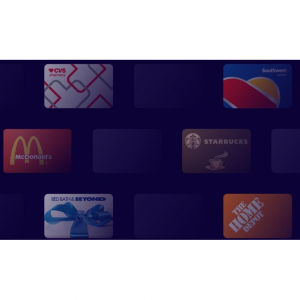
7 Best Gift Card Exchange Sites - Buy, Sell and Trade Discount Gift Card Safely and Instanly!
-

Top 9 Professional Skincare Brands for Licensed Estheticians 2025




